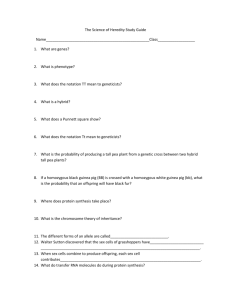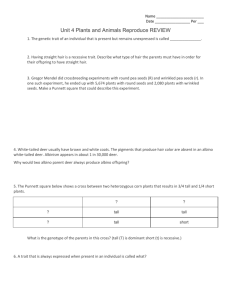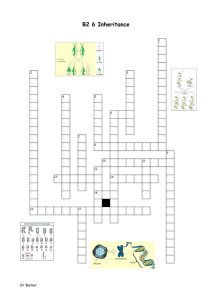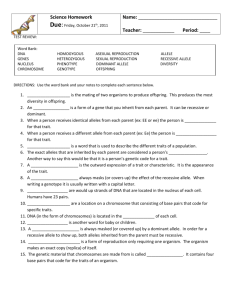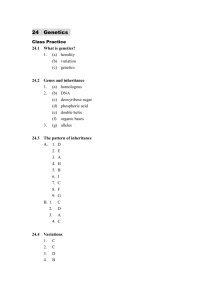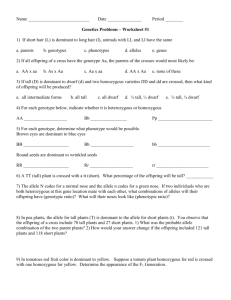Ch. 2 Conceptual Answers
advertisement
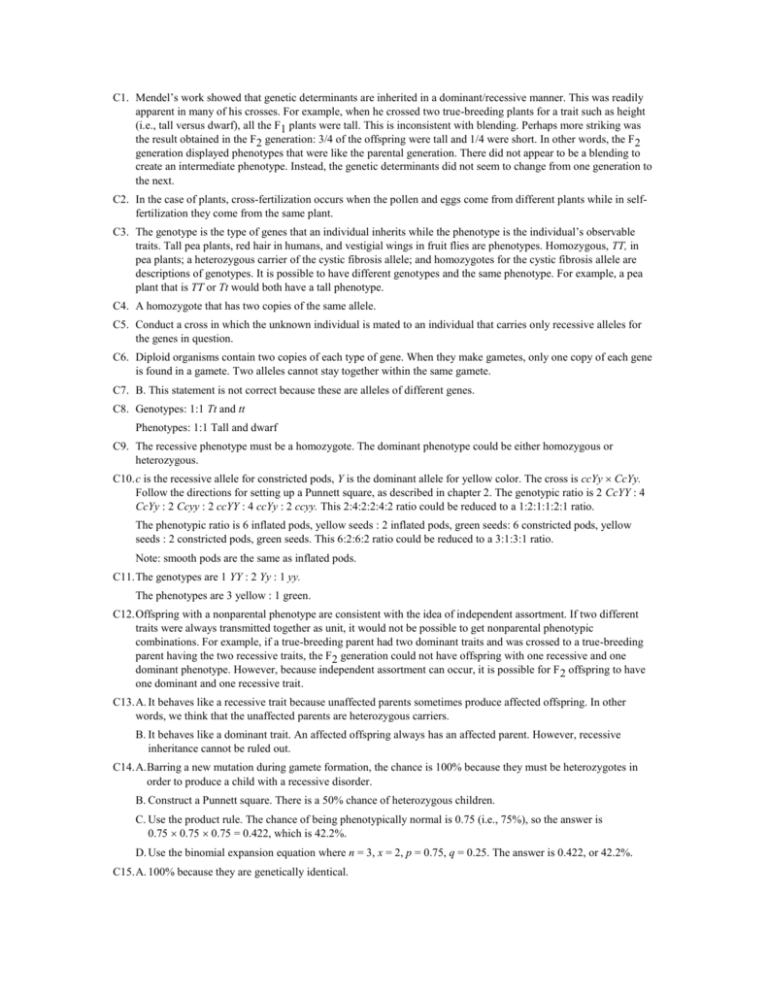
C1. Mendel’s work showed that genetic determinants are inherited in a dominant/recessive manner. This was readily apparent in many of his crosses. For example, when he crossed two true-breeding plants for a trait such as height (i.e., tall versus dwarf), all the F1 plants were tall. This is inconsistent with blending. Perhaps more striking was the result obtained in the F2 generation: 3/4 of the offspring were tall and 1/4 were short. In other words, the F 2 generation displayed phenotypes that were like the parental generation. There did not appear to be a blending to create an intermediate phenotype. Instead, the genetic determinants did not seem to change from one generation to the next. C2. In the case of plants, cross-fertilization occurs when the pollen and eggs come from different plants while in selffertilization they come from the same plant. C3. The genotype is the type of genes that an individual inherits while the phenotype is the individual’s observable traits. Tall pea plants, red hair in humans, and vestigial wings in fruit flies are phenotypes. Homozygous, TT, in pea plants; a heterozygous carrier of the cystic fibrosis allele; and homozygotes for the cystic fibrosis allele are descriptions of genotypes. It is possible to have different genotypes and the same phenotype. For example, a pea plant that is TT or Tt would both have a tall phenotype. C4. A homozygote that has two copies of the same allele. C5. Conduct a cross in which the unknown individual is mated to an individual that carries only recessive alleles for the genes in question. C6. Diploid organisms contain two copies of each type of gene. When they make gametes, only one copy of each gene is found in a gamete. Two alleles cannot stay together within the same gamete. C7. B. This statement is not correct because these are alleles of different genes. C8. Genotypes: 1:1 Tt and tt Phenotypes: 1:1 Tall and dwarf C9. The recessive phenotype must be a homozygote. The dominant phenotype could be either homozygous or heterozygous. C10. c is the recessive allele for constricted pods, Y is the dominant allele for yellow color. The cross is ccYyCcYy. Follow the directions for setting up a Punnett square, as described in chapter 2. The genotypic ratio is 2 CcYY : 4 CcYy : 2 Ccyy : 2 ccYY : 4 ccYy : 2 ccyy. This 2:4:2:2:4:2 ratio could be reduced to a 1:2:1:1:2:1 ratio. The phenotypic ratio is 6 inflated pods, yellow seeds : 2 inflated pods, green seeds: 6 constricted pods, yellow seeds : 2 constricted pods, green seeds. This 6:2:6:2 ratio could be reduced to a 3:1:3:1 ratio. Note: smooth pods are the same as inflated pods. C11. The genotypes are 1 YY : 2 Yy : 1 yy. The phenotypes are 3 yellow : 1 green. C12. Offspring with a nonparental phenotype are consistent with the idea of independent assortment. If two different traits were always transmitted together as unit, it would not be possible to get nonparental phenotypic combinations. For example, if a true-breeding parent had two dominant traits and was crossed to a true-breeding parent having the two recessive traits, the F2 generation could not have offspring with one recessive and one dominant phenotype. However, because independent assortment can occur, it is possible for F 2 offspring to have one dominant and one recessive trait. C13. A. It behaves like a recessive trait because unaffected parents sometimes produce affected offspring. In other words, we think that the unaffected parents are heterozygous carriers. B. It behaves like a dominant trait. An affected offspring always has an affected parent. However, recessive inheritance cannot be ruled out. C14. A. Barring a new mutation during gamete formation, the chance is 100% because they must be heterozygotes in order to produce a child with a recessive disorder. B. Construct a Punnett square. There is a 50% chance of heterozygous children. C. Use the product rule. The chance of being phenotypically normal is 0.75 (i.e., 75%), so the answer is 0.750.750.75 = 0.422, which is 42.2%. D. Use the binomial expansion equation where n = 3, x = 2, p = 0.75, q = 0.25. The answer is 0.422, or 42.2%. C15. A. 100% because they are genetically identical. B. Construct a Punnett square. We know the parents are heterozygotes because they produced a blue-eyed child. The fraternal twin is not genetically identical, but it has the same parents as its twin. The answer is 25%. C. The probability that an offspring inherits the allele is 50% and the probability that this offspring will pass it on to his/her offspring is also 50%. We use the product rule: (0.5)(0.5) = 0.25, or 25%. D. Barring a new mutation during gamete formation, the chance is 100% because they must be heterozygotes in order to produce a child with blue eyes. C16. First construct a Punnett square. The chances are 75% of producing a solid pup and 25% of producing a spotted pup. A. Use the binomial expansion equation where n = 5, x = 4, p = 0.75, q = 0.25. The answer is 0.396 = 39.6% of the time. B. You can use the binomial expansion equation for each litter. For the first litter, n = 6, x = 4, p = 0.75, q = 0.25; for the second litter, n = 5, x = 5, p = 0.75, q = 0.25. Since the litters are in a specified order, we use the product rule and multiply the probability of the first litter times the probability of the second litter. The answer is 0.070, or 7.0%. C. To calculate the probability of the first litter, we use the product rule and multiply the probability of the first pup (0.75) times the probability of the remaining four. We use the binomial expansion equation to calculate the probability of the remaining four, where n = 4, x = 3, p = 0.75, q = 0.25. The probability of the first litter is 0.316. To calculate the probability of the second litter, we use the product rule and multiply the probability of the first pup (0.25) times the probability of the second pup (0.25) times the probability of the remaining five. To calculate the probability of the remaining five, we use the binomial expansion equation, where n = 5, x = 4, p = 0.75, q = 0.25. The probability of the second litter is 0.025. To get the probability of these two litters occurring in this order, we use the product rule and multiply the probability of the first litter (0.316) times the probability of the second litter (0.025). The answer is 0.008, or 0.8%. D. Since this is a specified order, we use the product rule and multiply the probability of the firstborn (0.75) times the probability of the second born (0.25) times the probability of the remaining four. We use the binomial expansion equation to calculate the probability of the remaining four pups, where n = 4, x = 2, p = 0.75, q = 0.25. The answer is 0.040, or 4.0%. C17. If B is the black allele, and b is the white allele, the male is bb, the first female is probably BB, and the second female is Bb. We are uncertain of the genotype of the first female. She could be Bb, although it is unlikely because she didn’t produce any white pups out of a litter of eight. C18. A. Use the product rule: (1/4)(1/4)=1/16 B. Use the binomial expansion equation: n 4, p = 1/4, q = 3/4, x = 2 p = 0.21 = 21% C. Use the product rule: (1/4)(3/4)(3/4) = 0.14, or 14% C19. The parents must be heterozygotes so the probability is 1/4. C20. A. 1/4 B. 1, or 100% C. (3/4)(3/4)(3/4) = 27/64 = 0.42, or 42% D. Use the binomial expansion equation where n = 7, p = 3/4, q = 1/4, x = 3 P = 0.058, or 5.8% E. The probability that the first plant is tall is 3/4. To calculate the probability that among the next four, any two will be tall, we use the binomial expansion equation, where n = 4, p = 3/4, q = 1/4, and x = 2. The probability P equals 0.21. To calculate the overall probability of these two events: (3/4)(0.21) = 0.16, or 16% C21. A. T Y R, T y R, T Y r, T y r B. T Y r, t Y r C. T Y R, T Y r, T y R, T y r, t Y R, t Y r, t y R, t y r D. t Y r, t y r C22. It violates the law of segregation because there are two copies of one gene in the gamete. The two alleles for the A gene did not segregate from each other. C23. It is recessive inheritance. The pedigree is shown here. Affected individuals are shown with filled symbols. The mode of inheritance appears to be recessive. Unaffected parents (who must be heterozygous) produce affected children. C24. Based on this pedigree, it is likely to be dominant inheritance because an affected child always has an affected parent. In fact, it is a dominant disorder. C25. A. 3/16 B. (9/16)(9/16)(9/16) = 729/4096 = 0.18 C. (9/16)(9/16)(3/16)(1/16)(1/16) = 243/1,048,576 = 0.00023, or 0.023% D. Another way of looking at this is that the probability that it will have round, yellow seeds is 9/16. Therefore, the probability that it will not is 1 – 9/16 = 7/16. C26. It is impossible for the F1 individuals to be true-breeding because they are all heterozygotes. C27. This problem is a bit unwieldy, but we can solve it using the multiplication rule. For height, the ratio is 3 tall : 1 dwarf. For seed texture, the ratio is 1 round : 1 wrinkled. For seed color, they are all yellow. For flower location, the ratio is 3 axial : 1 terminal. Thus, the product is (3 tall + 1 dwarf)(1 round + 1 wrinkled)(1 yellow)(3 axial + 1 terminal) Multiplying this out, the answer is 9 tall, round, yellow, axial 9 tall, wrinkled, yellow, axial 3 tall, round, yellow, terminal 3 tall, wrinkled, yellow, terminal 3 dwarf, round, yellow, axial 3 dwarf, wrinkled, yellow, axial 1 dwarf, round, yellow, terminal 1 dwarf, wrinkled, yellow, terminal C28. 2 TY, tY, 2 Ty, ty, TTY, TTy, 2 TtY, 2 Tty It may be tricky to think about, but you get 2 TY and 2 Ty because either of the two T alleles could combine with Y or y. Also, you get 2 TtY and 2 Tty because either of the two T alleles could combine with t and then combine with Y or y. C29. The drone is sB and the queen is SsBb. According to the laws of segregation and independent assortment, the male can make only sB gametes, while the queen can make SB, Sb, sB, and sb, in equal proportions. Therefore, male offspring will be SB, Sb, sB, and sb, and female offspring will be SsBB, SsBb, ssBB, and ssBb. The phenotypic ratios, assuming an equal number of males and females, will be: Males 1 normal wings/black eyes Females 2 normal wings, black eyes 1 normal wings/white eyes 1 short wings/black eyes 1 short wings/white eyes 2 short wings, black eyes C30. The genotype of the F1 plants is Tt Yy Rr. According to the laws of segregation and independent assortment, the alleles of each gene will segregate from each other, and the alleles of different genes will randomly assort into gametes. A Tt Yy Rr individual could make eight types of gametes: TYR, TyR, Tyr, TYr, tYR, tyR, tYr, and tyr, in equal proportions (i.e., 1/8 of each type of gamete). To determine genotypes and phenotypes, you could make a large Punnett square that would contain 64 boxes. You need to line up the eight possible gametes across the top and along the side, and then fill in the 64 boxes. Alternatively, you could use one of the two approaches described in solved problem S3. The genotypes and phenotypes would be: 1 TT YY RR 2 TT Yy RR 2 TT YY Rr 2 Tt YY RR 4 TT Yy Rr 4 Tt Yy RR 4 Tt YY Rr 8 Tt Yy Rr = 27 tall, yellow, round 1 TT yy RR 2 Tt yy RR 2 TT yy Rr 4 Tt yy Rr = 9 tall, green, round 1 TT YY rr 2 TT Yy rr 2 Tt YY rr 4 Tt Yy rr = 9 tall, yellow, wrinkled 1 tt YY RR 2 tt Yy RR 2 tt YY Rr 4 tt Yy Rr = 9 dwarf, yellow, round 1 TT yy rr 2 Tt yy rr = 3 tall, green, wrinkled 1 tt yy RR 2 tt yy Rr = 3 dwarf, green, round 1 tt YY rr 2 tt Yy rr = 3 dwarf, yellow, wrinkled 1 tt yy rr = 1 dwarf, green, wrinkled C31. Construct a Punnett square to determine the probability of these three phenotypes. The probabilities are 9/16 for round, yellow; 3/16 for round, green; and 1/16 for wrinkled, green. Use the multinomial expansion equation described in Solved problem S7, where n = 5, a = 2, b = 1, c = 2, p = 9/16, q = 3/16, r = 1/16. The answer is 0.007, or 0.7%, of the time. C32. The wooly haired male is a heterozygote, because he has the trait and his mother did not. (He must have inherited the normal allele from his mother.) Therefore, he has a 50% chance of passing the wooly allele to his offspring; his offspring have a 50% of passing the allele to their offspring; and these grandchildren have a 50% chance of passing the allele to their offspring (the wooly haired man’s great-grandchildren). Since this is an ordered sequence of independent events, we use the product rule: 0.50.50.5 = 0.125, or 12.5%. Since there are no other Scandinavians on the island, there is an 87.5% chance of the offspring being normal (because they could not inherit the wooly hair allele from anyone else). We use the binomial expansion equation to determine the likelihood that one out of eight great-grandchildren will have wooly hair, where n = 8, x = 1, p = 0.125, q = 0.875. The answer is 0.393, or 39.3%, of the time. C33. A. Construct a Punnett square. Since it is a rare disease, we would assume that the mother is a heterozygote and the father is normal. The chances are 50% that the man in his thirties will have the allele. B. Use the product rule: 0.5 (chance that the man has the allele) times 0.5 (chance that he will pass it to his offspring), which equals 0.25, or 25%. C. We use the binomial expansion equation. From part B, we calculated that the probability of an affected child is 0.25. Therefore the probability of an unaffected child is 0.75. For the binomial expansion equation, n = 3, x = 1, p = 0.25, q = 0.75. The answer is 0.422 or 42.2%. C34. Use the product rule. If the woman is heterozygous, there is a 50% chance of having an affected offspring: (0.5)7 = 0.0078, or 0.78%, of the time. This is a pretty small probability. If the woman has an eighth child who is unaffected, however, she has to be a heterozygote, since it is a dominant trait. She would have to pass a normal allele to an unaffected offspring. The answer is 100%.
